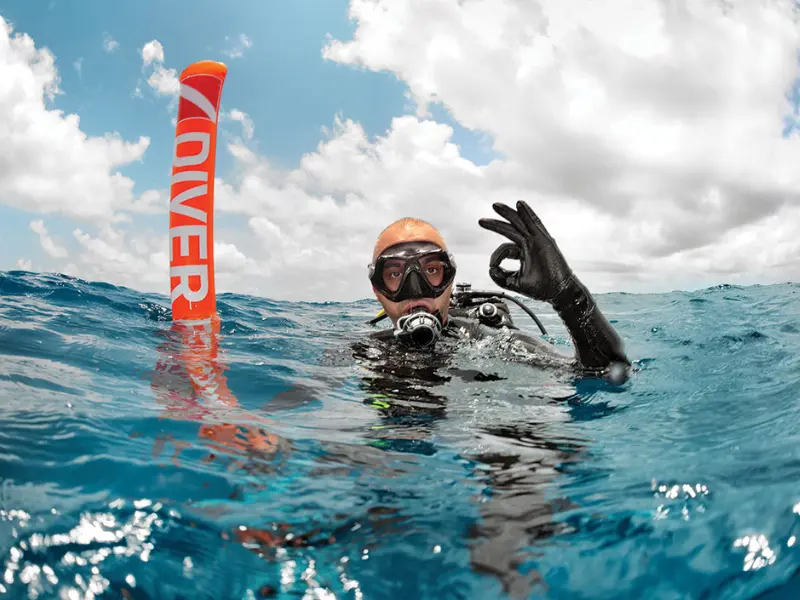1. Get proper training and certification
Get Proper Training and Certification: One of the most important things you can do to ensure a safe dive in the Red Sea is to get proper training and certification. This means taking a scuba diving course and becoming certified through a recognized diving organization, such as PADI or SSI. The course will teach you the basics of diving, including equipment usage, dive planning, and emergency procedures. Continuing your education and taking additional classes to expand your skills and knowledge as a diver is also essential.
Additionally, make sure your certification is current and up-to-date. If it’s been a while since your last dive, consider taking a refresher course to get back into the swing of things before diving in the Red Sea.
By getting proper training and certification, you’ll be prepared for the challenges and hazards of diving and can enjoy the experience with greater confidence and peace of mind.
2. Check your dive gear before each dive
Check Your Dive Gear Before Each Dive: Before each dive, it’s essential to thoroughly inspect and check your dive gear to ensure it’s in good working order. This includes your wetsuit, BCD, regulator, dive computer, fins, mask, and any other equipment you may be using.
Make sure everything fits properly and is in good condition. Check for any signs of wear and tear, leaks, or damage. Replace any worn or damaged equipment before diving.
Additionally, be familiar with the operation of your equipment and how to use it correctly. Make sure you know how to adjust your BCD, control your buoyancy, and monitor your air supply using your dive computer.
By checking your dive gear before each dive, you can prevent problems and ensure a safe and comfortable dive in the Red Sea.
3. Plan your dive, including depth, time, and location
Plan Your Dive: Before diving in the Red Sea, it’s essential to plan your dive, including the depth, time, and location. This will help you prepare for the dive and ensure you stay within your limits.
Consider the conditions, including water temperature, visibility, and currents, and plan your dive accordingly. Make sure you know the dive site and any hazards or restrictions that may be present.
Establishing clear dive plans with your partner, including the maximum depth, dive time, and emergency procedures, is also essential. Communicating and planning together can ensure that both divers are on the same page and prepared for any situation that may arise.
By planning your dive, you can dive safely and confidently in the Red Sea and make the most of your underwater experience.
4. Dive with a partner and establish clear communication
Dive with a Partner and Establish Clear Communication: Diving with a partner is critical to safe diving in the Red Sea. Not only does it provide a sense of security and support, but it also allows you to establish clear communication and coordinate your dive plan.
Before diving, ensure you and your partner agree on hand signals and emergency procedures. This will help you communicate underwater and respond effectively in the event of a problem.
Also, please stay close to your partner and keep an eye on each other throughout the dive. If either of you has a problem, the other can help and help if needed.
By diving with a partner and establishing clear communication, you can ensure a safe and enjoyable dive in the Red Sea.
5. Respect the marine life and avoid touching or disturbing the coral and creatures
Respect the Marine Life and Avoid Touching or Disturbing the Coral and Creatures: The Red Sea is home to a rich and diverse array of marine life, including colorful coral reefs, exotic fish, and other fascinating creatures. When diving in the Red Sea, it’s essential to respect this delicate ecosystem and avoid touching or disturbing marine life.
Please don’t touch the coral or other creatures, as the oils from your skin can harm them. Also, be mindful of your fins and other equipment, and avoid kicking or brushing against the reef.
Additionally, avoid damaging the coral by anchoring boats or dropping heavy objects on the reef. Remember, the health and preservation of the Red Sea’s coral reefs and marine life are essential for the long-term health and beauty of this unique and incredible underwater environment.
By respecting marine life and avoiding touching or disturbing the coral and creatures, you can help protect this precious ecosystem and ensure a safe and sustainable dive in the Red Sea.
6. Pay attention to currents and plan your dive accordingly
Manage Your Air Supply: Managing your air supply is essential to safe diving in the Red Sea. Monitor your air gauge regularly throughout the dive and maintain a secure air reserve.
Additionally, it’s important to pace yourself and avoid excessive physical exertion, as this can increase your air consumption. Make sure to stay relaxed and control your breathing throughout the dive.
In an emergency, it’s essential to have an alternate air source available, such as a spare regulator or an octopus. Know how to use these alternate air sources and be prepared to switch to them in the event of an air supply problem.
You can ensure a safe and controlled dive in the Red Sea by managing your air supply and preparing for emergencies.
7. Always use a dive computer and monitor your air supply
Monitor Your Depth and Dive Time: Monitoring your depth and dive time is crucial for safe diving in the Red Sea. Make sure to stay within the limits of your dive plan and keep track of your depth and time using a dive computer or depth gauge.
Additionally, be mindful of decompression obligations and safety stops, and follow the guidelines for safe ascents. Consider the conditions and your experience level when determining dive time and depth limits.
It’s also important to be aware of nitrogen narcosis, which can occur at deeper depths and affect your judgment and decision-making ability. You can ensure a safe dive in the Red Sea by monitoring your depth and dive time and being mindful of the effects of nitrogen narcosis.
8. Know and follow the dive flag rules
Use Appropriate Dive Gear: Appropriate dive gear is essential for safe diving in the Red Sea. Make sure to have all the necessary equipment, including a dive computer, dive light, and alternate air source, and that it is in good working order.
Also, choose a diving suit appropriate for the water temperature and conditions, and ensure it fits properly and provides adequate protection.
It’s also essential to carry a dive safety sausage, surface marker buoy, and whistle, as these are crucial signals for attracting attention in an emergency. Make sure you know how to use these signaling devices and have them readily accessible.
By using appropriate dive gear and having the necessary safety equipment, you can ensure a safe and comfortable dive in the Red Sea.
9. Stay hydrated and properly nourished before diving
Stay Hydrated and Nourished: Staying hydrated and nourished is essential for safe diving in the Red Sea. Ensure to drink plenty of water before, during, and after your dive to prevent dehydration.
Additionally, eat a well-balanced meal before diving to ensure that you have enough energy for the dive and to support your body’s physical demands.
It’s also essential to avoid alcohol and caffeine before diving, as these can increase dehydration and affect your judgment and decision-making ability.
By staying hydrated and nourished, you can help prevent fatigue and ensure a safe and successful dive in the Red Sea.
10. Be mindful of depth and nitrogen exposure
Plan Your Dive and Communicate with Your Dive Buddy: Planning your dive and communicating with your dive buddy is essential for safe diving in the Red Sea. Review the dive plan with your buddy and agree on the dive profile, including depth, dive time, and emergency procedures.
During the dive, maintain visual and verbal contact with your buddy and establish and follow clear hand signals to communicate important information.
It’s also essential to have an emergency plan in place and to know how to use your safety equipment and signals in the event of an emergency.
By planning your dive and communicating effectively with your dive buddy, you can ensure a safe and enjoyable dive experience in the Red Sea.









